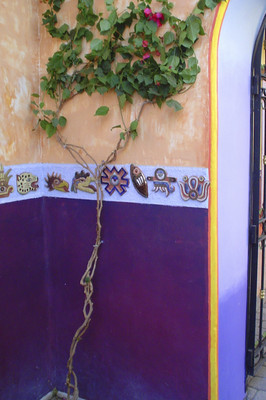Paint enlivens garden

Mother always said that paint could work miracles on an interior. What she didn’t know is how successful paint can be in the garden.
If you doubt this, travel anywhere in Mexico. Somehow the Mexicans know how to use vivid color to turn an ordinary concrete-block house into a celebration of color. Perhaps during hard times we, too, will discover why paint is so important — it’s cheap. Nothing can change the character of an outdoor space quite as effectively.
With gas prices keeping us grounded and the economy stifling every urge to move up in real estate, it’s time to start working more efficiently with what we have. That means rethinking your yard, since you may be spending a lot more time there now that everything costs more.
The problem is that we Americans have descended from New Englanders who painted with a uniform style. But if you’ve ever driven through a monochrome neighborhood into one with color, you know how important it is to creating an individual sense of place. Whether it’s a hot festive look you’re after or a feminine pastel haven, the key is not just the colors you choose, but knowing how great plants look against that color.
Green is never really green to your eye unless it’s played against a range of red hues from rose to carmine and even orange. Never underestimate the power of blue as a background — not the soft sky-blue we lean toward, but rich royal blue or ultramarine. Against these blues the flower colors pop out at you, lending a greater sense of three-dimensionality.
Truth be told, we don’t all have fabulous homes. In fact, the vast majority of American homes are average postwar tract models. Nobody wants to be stuck in suburbia forever, but if we create a fantasy environment in the backyard, maybe you won’t feel like such a suburbanite. Maybe you’ll feel more tropical — or perhaps you prefer a warm Italian courtyard, Moroccan terrace or the bound garden of a small home in the English countryside.
Now is the perfect time to play with paint. Get out your inner child and do some studies on that oppressive two-story wall, ugly board fence or barren back of your garage. There’s even paint for ugly concrete slabs.
A paint study is how architects determine what color to choose by painting big sample squares of color on the side of a building. There they can see it in large scale under sunlight all day long. This is safer than painting a building from a store chip that may look wholly different in the open air.
When choosing paint, know that it is forgiving. If you don’t like it, you can repaint in a different color. Sure it’s more work, but it’s affordable. So don’t worry about it. Surrender to color and forget what people or magazines tell you. Chances are, your instincts for what you like are better than someone else’s, even a designer’s.
Consider these five factors that can turn your color project into something amazing.
* Do not feel you must paint the whole yard one color.
* Pick two or three hues that work together and use these to create diversity.
* Experiment with faux effects to change the color and texture.
* Some paints may fade with time on sun-drenched walls.
* Use architectural plants against the wall for a striking effect.
Color is one of the best ways to liven up an ordinary yard when you’re on a budget. A gallon of paint and a roller is your low-cost recipe for a high-impact yard.
Maureen Gilmer is a horticulturist and former host of “Weekend Gardening” on DIY Network. Her blog, the MoZone, offers a groundbreaking series of great ideas for cash-strapped families to live more richly on less. Read the blog at www.MoPlants.com/blog. E-mail her at mogilmer@yahoo.com.